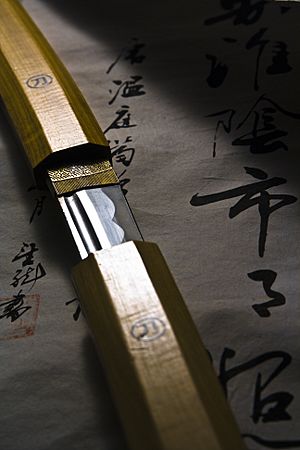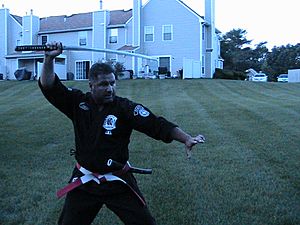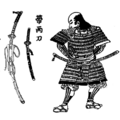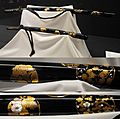Katana facts for kids
Quick facts for kids Katana |
|
|---|---|
|
Katana signed by Masamune with an inscription (Castle Izumi Mamoru possession) in gold inlay, Kamakura period, 14th century, blade length: 70.6 cm
|
|
| Type | Sword |
| Place of origin | Japan |
| Production history | |
| Produced | Muromachi period (1392–1573) to present |
| Specifications | |
| Mass | 1.1–1.3 kg |
| Blade length | approx. 60–73 cm (23+5⁄8–28+3⁄4 in) |
|
|
|
| Blade type | Curved, single-edged |
| Hilt type | Two-handed swept, with circular or squared guard |
| Scabbard/sheath | Lacquered wood |
A katana is a famous Japanese long sword. It was mainly used by samurai warriors, who were a special class of fighters in ancient Japan. The katana was the most important of the three swords a samurai would carry. The other two were the wakizashi and the tanto.
Katanas were very popular from about 1400 A.D. until 1876. This was when the samurai class was no longer part of Japanese society. In Japanese, "katana" simply means "long sword." It describes a blade that is slightly curved, has only one sharp edge, and a very pointed tip.
Contents
What are the Different Types of Katana?
There are several kinds of katanas, each with a different purpose:
- Artwork/Old Katana: These are called nihonto and are often very old and valuable.
- Sharpened Katana: Known as shinsaku or shinken, these are real, sharp swords.
- Modern Training Katana: Called iaito, these are made for practicing martial arts like iaido and iaijutsu.
- Decorative Katana: These swords are mostly for show or ceremonies and are not meant for fighting.
How is a Katana Made?
A traditional katana is made from a special type of steel called tamahagane. This steel comes from Japanese iron sand, which is melted in a big furnace called a tatara.
After the steel is made, it goes to a smith. The smith breaks the steel into small pieces and layers them based on how much carbon they have. They melt this steel in their forge and fold it many times. This folding makes the steel strong and even.
The most important step is tempering. This is when the sword is heated and then quickly cooled in water. Long ago, people believed that the sword's soul was put into the katana at this moment. The smith might do a rough polish, then the sword goes to a professional polisher. They polish it until it shines like a mirror. After polishing, the sword is ready to have its handle and guard added.
Today, most katanas are made from different types of carbon steel. Some are also made from zinc and aluminum alloys. These lighter swords are usually for decoration or for safe practice, not for real cutting. To know if a katana is good quality, people check how much it bends without breaking (its resistance). They also check if it can return to its original shape (its elasticity), and how long it lasts after hitting things (its endurance).
How Was the Katana Used?
Katanas were mostly designed for cutting, but they could also be used for stabbing. How it was used often depended on the length of the tang, which is the part of the blade that goes into the handle. If the katana was made for two hands, it was great for cutting. If it was for one hand, it was better for stabbing.
Samurai usually wore their katana under their belt on their left side. The sword was kept in its sheath, called a scabbard, with the blade facing up. This way, a samurai could draw the sword and cut an opponent in one smooth motion. Sometimes, a samurai might hold the scabbard freely in their left hand. This allowed them to move more easily during a fight.
Pulling the katana out of its scabbard even a little bit was a clear sign that a samurai was ready to fight.
Katana and Japanese Traditions
The katana was very important in Japanese society. People believed it held the "soul" of its owner. Only a samurai was allowed to own a katana. If a regular person carried one, they could be killed on the spot.
There were many traditions about how to wear, care for, and even draw a katana. Samurai kept their katanas on a special stand called a katana-kake. This stand held both the katana and the wakizashi. The blade had to point up, just like when it was worn. The handle, or tang, had to face left. This made sure the katana was always ready to be used.
The skill of using a katana was developed through martial arts like kenjutsu and iaijutsu. Today, these skills are still practiced in iaido and kendo. Kendo is a martial art where people duel using bamboo or wooden swords. Some old schools of katana handling still exist, such as Kashima Shin-ryu and Tenshin Shoden Katori Shinto-ryu.
One of the most respected techniques for using a katana is called Nitto Ryu. This school taught how to use both a katana and a wakizashi at the same time in a fight. The most famous samurai who mastered this art was Miyamoto Musashi.
Images for kids
-
Japanese Edo period wood block print (ca 1735) of a samurai with a tachi and a wakizashi (or kodachi).
-
A Sōshū school katana modified from a tachi, Kiriha Sadamune, forged by Sadamune, son of Masamune. 14th century, Kamakura period. Important Cultural Property. Tokyo National Museum
-
Muramasa (勢州桑名住村正) from the Tokyo National Museum
-
Daishō style handachi sword mounting. 16th-17th century, Azuchi–Momoyama or Edo period.
-
Antique Japanese daishō, the traditional pairing of two Japanese swords which were the symbol of the samurai, showing the traditional Japanese sword cases (koshirae) and the difference in size between the katana (bottom) and the smaller wakizashi (top).
-
Katana mountings decorated with maki-e lacquer in the 1800s. Although the number of forged swords decreased in the Meiji period, many artistically excellent mountings were made.
-
Japanese girl practicing iaidō with a modern training katana or iaitō. This sword was custom-made in Japan to suit the weight and size of the student. The blade is made of aluminum alloy and lacks a sharp edge for safety reasons.
-
Katana forged by Nagasone Kotetsu. The letters inlaid with gold on the tang (nakago) indicated that Yamano Kauemon (山野加右衛門), the official executioner of the Tokugawa shogunate and examiner of sword cutting performance, cut the four human torso overlapped.
-
Daishō style sword mounting, gold banding on red-lacquered ground. 16th century, Azuchi–Momoyama period. Important Cultural Property. Tokyo National Museum. These swords were owned by Toyotomi Hideyoshi.
-
Katana mounting with a polished black lacquer sheath, Edo period. Museum of Fine Arts, Boston.
-
Mounting for a katana forged by Motoshige. late 16th or early 17th century, Azuchi–Momoyama or Edo period. Important Cultural Property. Tokyo National Museum.
See also
 In Spanish: Katana para niños
In Spanish: Katana para niños






























